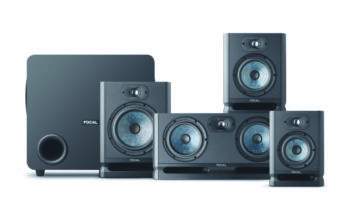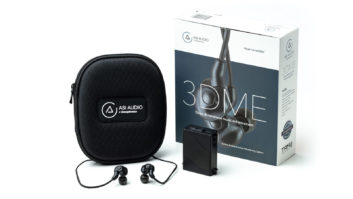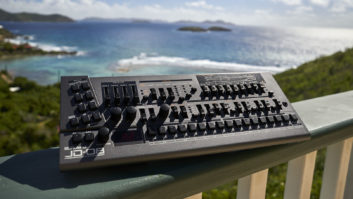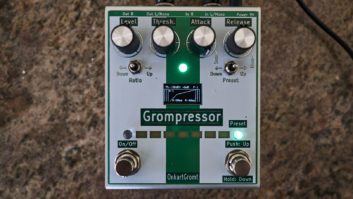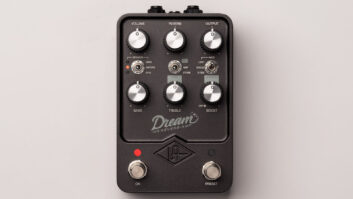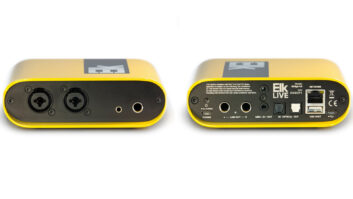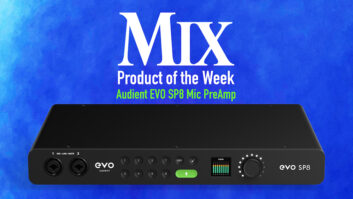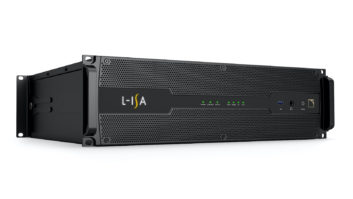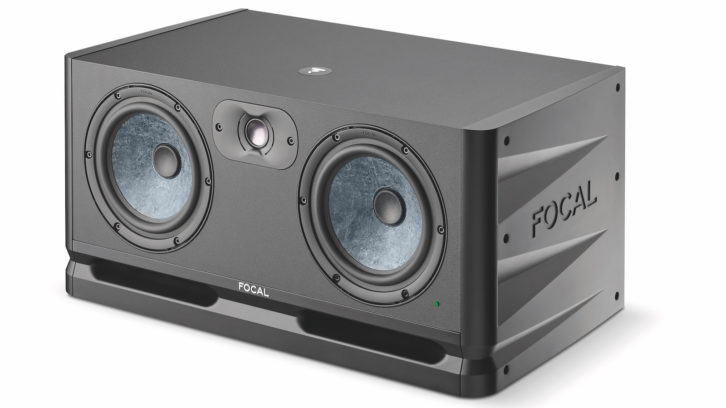
When I see or hear the name Focal, my first thought is high-end monitors from France with prices to match, but the manufacturer’s Alpha Evo range is surprisingly affordable relative to its other professional monitors. Recently, the company released a new flagship for the line: the Alpha Twin Evo.
Design-wise, it’s a departure from its siblings. Rather than a biamplified configuration, the Alpha Twin Evo is triamplified. The three drivers include two 6.5-inch woofers and a 1-inch tweeter that sits above and between them. Focal equipped each monitor with 50 W amplifiers for each woofer and a 30 W amp for the tweeter.
The solidly built MDF cabinets were designed to be horizontally oriented only. You’ll need enough room in your studio for the 22-inch width. Each monitor features two ports at the bottom—one under each woofer. Focal manufactured the woofers with its rigid composite Slatefiber material, designed for neutral frequency response without distortion.
The 1-inch tweeter is Focal’s proprietary aluminum-inverted dome type. According to the company, it exhibits lower directivity than other tweeter types, making the sweet spot of the monitor wider. In the box with each Alpha Twin Evo are protective metal grilles for the woofers and the tweeter that snap in easily around the drivers and have notches on the bottom and top, making them easy to remove. To my ears, the grilles reduce the monitor’s high-end response and output level ever so slightly.
If you want to significantly adjust the frequency response to fit your room, you can do so with the built-in low- and high-shelving EQs. The High knob offers +/-3 dB between 4.5 kHz and 35 kHz. The Low knob provides a whopping +/-6 dB between 0 Hz and 250 Hz. These broad EQs allow you to change the balance of the tweeter and the woofers to compensate for acoustic anomalies in your studio.
THREE-WAY ACTION
Focal included three connectivity options on each Alpha Twin Evo: XLR, balanced 1/4-inch, and unbalanced RCA. Not only does this arrangement give you options to fit almost any system, but you can connect up to three sources simultaneously.
The power switch resides on the rear panel, as does another switch to turn on and off the Automatic Standby Mode. When it’s engaged, the monitors go into Standby after 15 minutes of receiving no signal, and the front panel LED turns from green to red. When you next send a signal to the monitors, it takes a few seconds for them to ramp back up, but it’s a small price to pay for the energy savings it provides.
One of the other user-selectable options on the back is a Sensitivity switch that toggles the operating level between 0 dB and +6 dB, allowing you to adjust the monitors to fit your system.
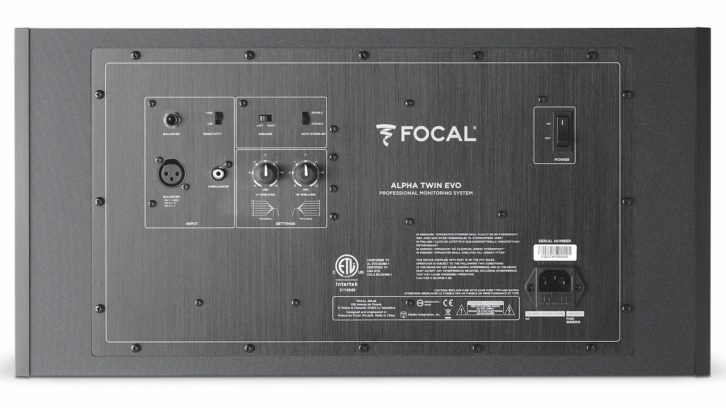
WHICH SIDE ARE YOU ON?
A unique aspect of the Alpha Twin Evo is its twin-woofer design. One of the woofers carries mainly bass frequencies (250 Hz and below), the other handles the midrange, and you can control which one does which. Because of the woofer’s horizontal orientation, you can choose to have the midrange woofers toward the inside or outside of your listening position.
To flip them, you only need to flick the Speaker switch on each monitor to Left or Right. Focal recommends setting the left monitor to Right and the right monitor to Left, which puts the midrange woofers toward the center and the bass on the outside.
If you don’t read the manual, you might assume the switches are for designating the left and right speaker rather than the position of the bass and midrange woofers. To avoid confusion, Focal should have given the control a more descriptive name, like “Woofer Position.”
Regarding the manual, I have good and bad news. The former is that Focal includes a paper manual and also posts a PDF version on its site. The bad news is that the manual is in multiple languages, making it particularly hard to navigate online. I understand the need to include the various languages in the printed manual that goes in the box. But for online, where printing costs aren’t an issue, creating single-language manuals would be much more convenient.
The manual not only combines languages but products, too. It covers the entire Alpha Evo line. This can lead to confusion over features (for example, the manual makes it sound like the Alpha Twin Evos have mounting points, although they don’t). I’d like to see Focal create product-specific manuals, particularly for the online PDFs.
HEARING IS BELIEVING
I set up the Alpha Twin Evos on monitor stands in my studio with heavy-duty monitor isolation pads underneath them. I used them as my primary monitors for several weeks, doing several mixes and listening to various types of recorded music.
With a max SPL rating of 108 dB (peak at 1m), the Alpha Twin Evos offer plenty of clean power. I typically monitor at about 75 dB but occasionally turn the volume up loud for comparison. When I did, the Focals stayed crisp and clean.
In addition to monitoring from my normal near-field listening position, I tried moving back a couple of feet and turning up the volume, and the sound quality remained excellent. With their power and size, you could probably use these monitors in a midfield configuration.
Whether listening at soft, moderate or loud levels, the most impressive aspect of the Alpha Twin Evos was their clarity and detail. Sources like acoustic guitars, hi-hats and hand percussion were vivid in the soundstage. I even noticed some subtle high-end issues on one mix that I hadn’t heard on my regular monitors.
I found the built-in shelving EQs well-voiced and quite handy in my studio. I don’t usually need to adjust the high end on monitors, but the Alpha Twin Evos were so crisp and bright that I ended up turning the HF Shelving down by 2 dB to take the edge off a little.
My studio tends to absorb bass, so I boosted the LF Shelving knobs by 2 dB. The result was bass frequencies that sounded fuller but never boomy or indistinct.
I also tried setting up the monitors in a 2.1 system with my KRK S10.4 subwoofer. The result was a big, full-range sound. I assume that with a matching Focal Sub, the results would be even better. You might consider adding a sub if you’re producing hip-hop or EDM.
For the kind of music I produce—acoustic instrumentals, rootsy rock and alt-country—I didn’t feel the need for a sub. I was extremely satisfied with the low-end response of the Alpha Twin Evos on their own. The bass sounded impressively tight. I found it easier than with my regular (8-inch) monitors to judge bass levels and balance the kick drum versus the bass guitar.
I credit the Alpha Twin Evos with inspiring me to finish some mixes for an instrumental project of mine that had vexed me for a while. I was never satisfied with the results when mixing on my regular monitors, but the detail I heard when using the Focals helped me produce mixes that significantly surpassed my previous efforts.
Overall, I was extremely pleased with the Alpha Twin Evos. Their clarity across the frequency spectrum is exceptional, and they have plenty of power. The additional features that Focal included, like the variety of input formats, shelving EQ and Auto Standby Mode, are straightforward and useful.
If you’re looking for professional-quality monitors for tracking and mixing music or for post-production, and you’re okay with horizontally oriented monitors, the Alpha Twin Evos are an excellent choice at a surprisingly low cost.
PRODUCT SUMMARY
COMPANY: Focal
PRODUCT: Alpha Twin Evo
WEBSITE: www.focal.com
PRICE: $659 (each)
PROS: Extremely detailed in all frequency ranges. Excellent value. Low- and high-shelving filters helpful in compensating for room acoustics. Three types of input formats. Up to three simultaneous sources. Auto-Standby feature saves energy. Metal speaker grilles included.
CONS: Supports horizontal positioning only. “Speaker” switches are confusingly named. Multi-language, multi-product manual inconvenient.
